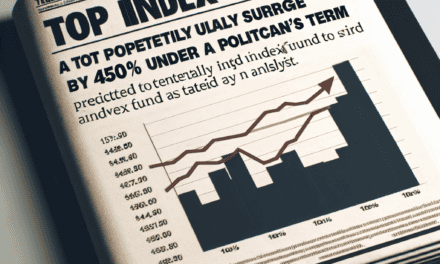“Asian Markets Soar: Riding the Wave of US Optimism After Fed Rate Cut”
Introduction
Asian markets experienced a significant surge following a robust rally in the United States, spurred by the Federal Reserve’s recent decision to cut interest rates. This monetary policy adjustment, aimed at stimulating economic growth amid global uncertainties, has bolstered investor confidence, leading to a ripple effect across major Asian stock exchanges. Key indices in Japan, China, and South Korea posted notable gains as investors reacted positively to the Fed’s move, interpreting it as a commitment to supporting economic stability. The rate cut has also alleviated some concerns over trade tensions and economic slowdowns, encouraging a more optimistic outlook in the region’s financial markets.
Impact Of US Fed Rate Cut On Asian Stock Markets
The recent decision by the United States Federal Reserve to cut interest rates has sent ripples across global financial markets, with Asian stock markets experiencing a notable surge in response. This development underscores the interconnectedness of global economies and highlights the significant influence that U.S. monetary policy exerts on international markets. As investors digest the implications of the Fed’s move, Asian markets have responded with optimism, reflecting a broader sentiment of renewed confidence.
The Federal Reserve’s decision to lower interest rates was largely anticipated by market analysts, who had been closely monitoring economic indicators and the Fed’s communications. The rate cut is intended to stimulate economic activity by making borrowing cheaper, thereby encouraging spending and investment. This move comes amid concerns about slowing economic growth and geopolitical uncertainties, which have prompted central banks worldwide to adopt more accommodative monetary policies.
In the wake of the Fed’s announcement, U.S. stock markets rallied, setting the stage for a positive reaction in Asian markets. The surge in Asian equities can be attributed to several factors, including the prospect of increased capital flows into the region. Lower interest rates in the U.S. often lead to a search for higher yields elsewhere, making Asian markets an attractive destination for investors seeking better returns. Consequently, this influx of capital can drive up stock prices, as seen in the recent market movements.
Moreover, the Fed’s rate cut has alleviated some of the pressure on Asian central banks to lower their own interest rates. With the U.S. taking the lead in monetary easing, Asian policymakers may find more room to maneuver without the immediate need to adjust their rates. This provides a window of opportunity for Asian economies to focus on domestic growth strategies while benefiting from the positive spillover effects of the Fed’s actions.
In addition to the direct impact on stock prices, the Fed’s decision has also influenced currency markets. The U.S. dollar has experienced some depreciation following the rate cut, which has implications for Asian currencies. A weaker dollar can enhance the competitiveness of Asian exports by making them cheaper for foreign buyers, potentially boosting trade balances and supporting economic growth in the region.
However, it is important to note that while the initial reaction in Asian markets has been positive, the long-term effects of the Fed’s rate cut remain uncertain. Investors will continue to monitor economic data and geopolitical developments to assess the sustainability of this rally. Furthermore, the global economic landscape is fraught with challenges, including trade tensions and the ongoing recovery from the pandemic, which could influence market dynamics in the coming months.
In conclusion, the U.S. Federal Reserve’s decision to cut interest rates has had a significant impact on Asian stock markets, triggering a surge in equities and influencing currency valuations. This development highlights the intricate linkages between global financial systems and the pivotal role of U.S. monetary policy in shaping market sentiment. As Asian markets continue to navigate this evolving landscape, the interplay between domestic economic conditions and international influences will be crucial in determining their trajectory. Investors and policymakers alike will need to remain vigilant, adapting to new information and adjusting strategies to capitalize on emerging opportunities while mitigating potential risks.
Key Asian Markets Leading The Surge After US Rally
Asian markets experienced a significant surge following a robust rally in the United States, which was spurred by the Federal Reserve’s decision to cut interest rates. This monetary policy adjustment, aimed at stimulating economic growth, has had a ripple effect across global markets, with key Asian indices leading the charge. Investors in the region have responded positively to the Fed’s move, viewing it as a signal of potential economic stability and growth, which has, in turn, bolstered market confidence.
In particular, the Tokyo Stock Exchange saw a notable uptick, with the Nikkei 225 index climbing to its highest levels in recent months. This rise can be attributed to increased investor optimism, driven by the expectation that lower borrowing costs in the United States will lead to enhanced corporate earnings and consumer spending. Japanese exporters, in particular, stand to benefit from a weaker yen, which often accompanies such rate cuts, making their goods more competitive in international markets.
Similarly, the Shanghai Composite Index in China also experienced a significant boost. The Chinese market’s response is partly due to the interconnectedness of the global economy, where developments in the United States often have far-reaching implications. Moreover, the rate cut has alleviated some concerns about the ongoing trade tensions between the US and China, as it suggests a willingness on the part of the US to support economic growth. This has provided a much-needed sense of relief to investors who have been wary of the potential negative impacts of prolonged trade disputes.
In South Korea, the KOSPI index mirrored this upward trend, driven by gains in technology stocks. South Korea’s economy, heavily reliant on exports, particularly in the tech sector, stands to gain from improved global economic conditions. The Fed’s decision has been perceived as a positive development for South Korean tech giants, which are integral to the country’s economic health. As a result, investor sentiment has improved, leading to increased market activity and higher stock valuations.
Furthermore, the Indian stock market has also benefited from the US rally, with the Sensex and Nifty indices showing marked improvements. India’s economy, which has been grappling with its own set of challenges, including inflation and currency fluctuations, has found some respite in the Fed’s rate cut. The move is expected to attract foreign investment into the Indian market, as investors seek higher returns in emerging economies. This influx of capital is likely to support domestic growth initiatives and provide a boost to key sectors such as infrastructure and manufacturing.
In conclusion, the recent surge in Asian markets can be largely attributed to the positive sentiment generated by the US Federal Reserve’s decision to cut interest rates. This move has not only provided a short-term boost to investor confidence but also set the stage for potential long-term economic benefits across the region. As Asian markets continue to respond to global economic cues, the interplay between domestic policies and international developments will remain a critical factor in shaping their trajectories. The current rally underscores the importance of global economic interdependence and highlights the potential for coordinated policy actions to foster stability and growth in an increasingly interconnected world.
Sector-Wise Analysis Of Asian Market Gains Post Fed Decision
The recent surge in Asian markets, following a rally in the United States, has captured the attention of investors and analysts alike. This upward momentum was largely driven by the Federal Reserve’s decision to cut interest rates, a move that has reverberated across global financial markets. As we delve into the sector-wise analysis of Asian market gains, it becomes evident that the impact of the Fed’s decision has been both profound and multifaceted.
To begin with, the technology sector in Asia has experienced significant gains. This sector, which is often sensitive to changes in interest rates due to its reliance on capital for growth and innovation, has benefited from the lower borrowing costs. Companies in countries like South Korea and Taiwan, which are home to some of the world’s leading tech giants, have seen their stock prices rise as investors anticipate increased profitability and expansion opportunities. Moreover, the tech sector’s performance has been bolstered by strong demand for semiconductors and consumer electronics, further amplifying the positive effects of the Fed’s rate cut.
In addition to technology, the financial sector has also shown robust performance. Banks and financial institutions across Asia have welcomed the Fed’s decision, as lower interest rates can lead to increased lending activity and improved margins. In particular, banks in Japan and China have reported gains, as the rate cut is expected to stimulate economic activity and boost consumer confidence. Furthermore, the financial sector’s gains have been supported by a favorable regulatory environment and ongoing digital transformation efforts, which have enhanced operational efficiencies and customer engagement.
Transitioning to the manufacturing sector, the impact of the Fed’s rate cut has been somewhat mixed. While some manufacturers have benefited from reduced borrowing costs and increased demand for exports, others have faced challenges due to supply chain disruptions and geopolitical tensions. Nonetheless, the overall sentiment in the manufacturing sector remains positive, as companies continue to adapt to changing market conditions and explore new growth opportunities. In particular, manufacturers in countries like Vietnam and Thailand have shown resilience, leveraging their competitive advantages in labor and production costs to capture a larger share of the global market.
The consumer goods sector, on the other hand, has experienced a more uniform positive impact. With lower interest rates encouraging consumer spending, companies in this sector have reported increased sales and improved profit margins. Retailers and consumer goods manufacturers in India and Indonesia, for example, have capitalized on the growing middle class and rising disposable incomes, further driving sectoral gains. Additionally, the shift towards e-commerce and digital platforms has provided new avenues for growth, enabling companies to reach a broader customer base and enhance their market presence.
Finally, the energy sector has also seen notable gains, albeit with some caution. While lower interest rates have reduced financing costs for energy projects, the sector remains sensitive to fluctuations in global oil prices and environmental regulations. Nevertheless, energy companies in countries like Malaysia and Indonesia have benefited from increased demand for renewable energy and government initiatives aimed at promoting sustainable development.
In conclusion, the Fed’s decision to cut interest rates has had a significant and varied impact on different sectors within the Asian markets. While technology and financial sectors have emerged as clear winners, other sectors like manufacturing and consumer goods have also shown resilience and adaptability. As investors continue to navigate this dynamic landscape, the interplay between global economic policies and regional market conditions will remain a key factor in shaping future market trends.
Investor Sentiment In Asia Following US Federal Reserve Actions
Investor sentiment in Asia has experienced a notable uplift following a significant rally in the United States stock markets, which was triggered by the Federal Reserve’s recent decision to cut interest rates. This move by the Fed, aimed at stimulating economic growth amid global uncertainties, has had a ripple effect across international markets, particularly in Asia, where investors are closely monitoring the implications of U.S. monetary policy on their own economic landscapes.
The Federal Reserve’s decision to lower interest rates was largely anticipated by market analysts, who had been speculating on the central bank’s next steps in response to slowing economic indicators and ongoing trade tensions. By reducing borrowing costs, the Fed aims to encourage spending and investment, thereby bolstering economic activity. This policy shift has been met with enthusiasm by investors, who view it as a proactive measure to sustain growth and mitigate potential downturns.
In the wake of the Fed’s announcement, U.S. stock markets experienced a robust rally, with major indices posting significant gains. This positive momentum quickly spread to Asian markets, where investors were eager to capitalize on the improved outlook. As a result, key Asian indices, including Japan’s Nikkei, Hong Kong’s Hang Seng, and South Korea’s KOSPI, saw substantial increases, reflecting heightened investor confidence.
The surge in Asian markets can be attributed to several factors. Firstly, the Fed’s rate cut is perceived as a signal of continued support for the global economy, which is particularly reassuring for export-driven Asian economies that are sensitive to shifts in international demand. Additionally, lower U.S. interest rates tend to weaken the dollar, making Asian exports more competitive and potentially boosting trade balances in the region.
Moreover, the Fed’s actions have prompted central banks in Asia to reassess their own monetary policies. Some Asian economies, facing similar challenges of slowing growth and external pressures, may consider adopting more accommodative stances to align with the Fed’s approach. This potential for synchronized monetary easing across major economies further enhances investor optimism, as it suggests a coordinated effort to sustain global economic stability.
However, it is important to note that while the immediate reaction in Asian markets has been positive, there are underlying risks that investors must remain vigilant about. The ongoing trade tensions between the U.S. and China continue to pose a significant threat to global economic prospects. Any escalation in these disputes could quickly dampen the current optimism and lead to increased volatility in financial markets.
Furthermore, while the Fed’s rate cut provides short-term relief, it also raises questions about the long-term sustainability of such measures. Investors are keenly aware that reliance on monetary policy alone may not be sufficient to address structural economic challenges. Therefore, they are closely watching for any signs of fiscal policy interventions or structural reforms that could complement the central bank’s efforts.
In conclusion, the recent surge in Asian markets following the U.S. rally post-Fed rate cut underscores the interconnectedness of global financial systems and the significant influence of U.S. monetary policy on investor sentiment worldwide. While the current environment is characterized by optimism and opportunity, it is also fraught with uncertainties that require careful navigation. As investors in Asia continue to respond to these developments, their focus will likely remain on both the actions of central banks and the broader geopolitical landscape, which together will shape the future trajectory of regional markets.
Comparative Study: Asian Markets Vs. Global Markets Post US Rate Cut
The recent surge in Asian markets following a rally in the United States has captured the attention of global investors, highlighting the interconnectedness of international financial systems. This upward momentum was primarily triggered by the Federal Reserve’s decision to cut interest rates, a move aimed at stimulating economic growth amid concerns of a potential slowdown. As the ripple effects of this decision spread across the globe, it becomes imperative to examine how Asian markets have responded in comparison to their global counterparts.
In the wake of the Federal Reserve’s rate cut, Asian markets experienced a notable upswing, with major indices such as the Nikkei 225, Hang Seng, and Shanghai Composite showing significant gains. This positive response can be attributed to several factors, including increased investor confidence and the anticipation of improved economic conditions. The rate cut has effectively lowered borrowing costs, encouraging businesses to invest and expand, which in turn boosts market sentiment. Moreover, the prospect of a more accommodative monetary policy in the United States has alleviated fears of a global economic downturn, providing a much-needed boost to Asian economies that are heavily reliant on exports.
Transitioning to a broader perspective, it is essential to consider how these developments in Asian markets compare to those in other regions. In Europe, for instance, markets have also reacted positively, albeit with a more cautious optimism. The European Central Bank has been grappling with its own set of challenges, including sluggish growth and geopolitical uncertainties, which have tempered the enthusiasm seen in Asian markets. Nevertheless, the Fed’s rate cut has provided a degree of reassurance, leading to modest gains across European indices.
In contrast, emerging markets outside of Asia have exhibited a more varied response. While some countries have benefited from the increased risk appetite among investors, others have faced challenges due to domestic economic issues and political instability. For instance, Latin American markets have shown mixed results, with countries like Brazil experiencing gains, while others remain subdued. This divergence underscores the importance of local factors in shaping market reactions, even in the context of global monetary policy shifts.
Furthermore, the impact of the US rate cut on currency markets cannot be overlooked. The decision has led to a depreciation of the US dollar, which has had varying effects on Asian currencies. For export-driven economies like Japan and South Korea, a weaker dollar is advantageous as it makes their goods more competitive in international markets. Conversely, for countries with significant dollar-denominated debt, such as Indonesia, a weaker dollar eases repayment burdens, providing additional economic relief.
In conclusion, the recent rally in Asian markets following the US Federal Reserve’s rate cut highlights the complex interplay between global monetary policy and regional economic dynamics. While Asian markets have generally responded with enthusiasm, the reactions in other parts of the world have been more nuanced, reflecting a range of economic conditions and challenges. As investors continue to navigate this evolving landscape, the importance of understanding these regional differences becomes increasingly apparent. Ultimately, the interconnected nature of global markets means that developments in one region can have far-reaching implications, underscoring the need for a comprehensive and informed approach to investment strategies.
Long-Term Implications Of Fed Rate Cut On Asian Economies
The recent surge in Asian markets, following a rally in the United States, has captured the attention of global investors and policymakers alike. This upswing was largely driven by the Federal Reserve’s decision to cut interest rates, a move that has significant implications for economies across Asia. As the ripple effects of this monetary policy adjustment spread, it is crucial to examine the long-term implications for Asian economies, which are intricately linked to global financial dynamics.
To begin with, the Federal Reserve’s rate cut is primarily aimed at stimulating economic growth by making borrowing cheaper, thereby encouraging investment and consumption. This policy shift has led to increased liquidity in the global financial system, which often results in capital flows to emerging markets, including those in Asia. Consequently, Asian economies may experience an influx of foreign investment, which can bolster economic growth and development. However, while this capital inflow can be beneficial, it also poses challenges, such as the risk of asset bubbles and increased volatility in financial markets.
Moreover, the rate cut has implications for currency valuations. Typically, a reduction in US interest rates leads to a depreciation of the US dollar, making Asian exports more competitive in global markets. This can provide a much-needed boost to export-driven economies in the region, such as China, South Korea, and Japan. However, the flip side is that a weaker dollar can also lead to currency appreciation in Asian countries, potentially impacting their export competitiveness over the long term. Policymakers in these nations must therefore carefully manage their exchange rates to maintain a balance between fostering growth and ensuring economic stability.
In addition to affecting trade dynamics, the Fed’s rate cut also influences monetary policy decisions within Asian economies. Central banks in the region may feel compelled to adjust their own interest rates in response to maintain competitive exchange rates and control inflationary pressures. This synchronization of monetary policies can lead to a more stable economic environment, but it also limits the autonomy of individual countries in setting their own economic agendas. As a result, Asian economies must navigate the delicate balance between aligning with global monetary trends and addressing domestic economic needs.
Furthermore, the long-term implications of the Fed’s rate cut extend to the realm of debt management. Many Asian countries have accumulated significant levels of debt, both public and private, in recent years. Lower interest rates can ease the burden of debt servicing, providing relief to heavily indebted nations. However, this also raises concerns about the sustainability of debt levels, as prolonged periods of low interest rates may encourage excessive borrowing and lead to financial vulnerabilities.
In conclusion, while the immediate impact of the Federal Reserve’s rate cut has been a surge in Asian markets, the long-term implications for Asian economies are multifaceted and complex. The potential for increased foreign investment, shifts in trade dynamics, and changes in monetary policy all present both opportunities and challenges. As Asian economies continue to integrate into the global financial system, they must remain vigilant in managing these dynamics to ensure sustainable growth and stability. The interplay between global monetary policies and regional economic strategies will undoubtedly shape the future trajectory of Asian economies in the years to come.
Role Of Currency Fluctuations In Asian Market Surge After US Rate Cut
The recent surge in Asian markets, following a rally in the United States, can be attributed to a multitude of factors, with currency fluctuations playing a pivotal role. The Federal Reserve’s decision to cut interest rates has had a ripple effect across global financial markets, influencing investor sentiment and capital flows. As the US dollar weakened in response to the rate cut, Asian currencies experienced varying degrees of appreciation, which in turn impacted the performance of regional stock markets.
To begin with, the depreciation of the US dollar typically makes Asian exports more competitive on the global stage. This is because a weaker dollar reduces the cost of goods priced in other currencies, thereby boosting demand for Asian products. Consequently, export-driven economies in Asia, such as China, South Korea, and Japan, have seen a positive impact on their stock markets. Investors, anticipating increased corporate earnings from higher export volumes, have been more inclined to invest in these markets, driving up stock prices.
Moreover, the currency fluctuations have also affected capital flows into Asian markets. A lower interest rate environment in the United States often leads to a search for higher yields elsewhere, prompting investors to redirect their capital towards emerging markets in Asia. This influx of foreign investment not only bolsters stock prices but also strengthens local currencies, creating a virtuous cycle of growth and investment. As a result, countries with relatively stable economic fundamentals and attractive yields have become prime destinations for international investors seeking to capitalize on the shifting monetary landscape.
In addition to these factors, the interplay between currency fluctuations and inflation expectations cannot be overlooked. A weaker US dollar can lead to higher import prices for Asian countries, potentially stoking inflationary pressures. However, central banks in the region have been vigilant in managing these pressures, employing a mix of monetary policy tools to maintain price stability. By doing so, they have been able to sustain investor confidence, further contributing to the market surge.
Furthermore, the role of currency fluctuations extends beyond immediate market reactions, influencing long-term economic strategies in the region. For instance, countries may take advantage of a stronger currency to invest in infrastructure and technology, enhancing their competitive edge in the global market. This strategic positioning not only supports sustained economic growth but also attracts further investment, reinforcing the positive momentum in financial markets.
It is also important to consider the geopolitical context in which these currency fluctuations occur. Trade tensions, particularly between the United States and China, have been a significant source of uncertainty for global markets. However, the recent rate cut by the Federal Reserve has been perceived as a stabilizing force, alleviating some of the concerns surrounding trade disputes. This has provided a more favorable backdrop for Asian markets, allowing them to capitalize on the opportunities presented by currency movements.
In conclusion, the surge in Asian markets following the US rally post-Fed rate cut underscores the intricate relationship between currency fluctuations and market dynamics. As investors navigate this complex landscape, understanding the multifaceted impact of currency movements is crucial for making informed investment decisions. By recognizing the interconnectedness of global financial systems, stakeholders can better anticipate market trends and position themselves to benefit from the evolving economic environment.
Q&A
1. **What caused the Asian markets to surge?**
The Asian markets surged following a rally in the US markets, which was driven by a Federal Reserve rate cut aimed at stimulating economic growth.
2. **Which Asian stock indices saw significant gains?**
Major Asian stock indices such as the Nikkei 225 in Japan, the Hang Seng Index in Hong Kong, and the Shanghai Composite in China saw significant gains.
3. **How did the US Federal Reserve’s decision impact global investor sentiment?**
The US Federal Reserve’s rate cut improved global investor sentiment by signaling a supportive monetary policy environment, encouraging investment in equities.
4. **What sectors in the Asian markets benefited the most from the surge?**
Sectors such as technology, finance, and consumer goods benefited the most from the surge in Asian markets.
5. **How did currency markets react to the Fed rate cut and subsequent Asian market surge?**
Currency markets saw a weakening of the US dollar, while Asian currencies like the Japanese yen and Chinese yuan experienced relative strength.
6. **What are the potential risks associated with the market surge following the Fed rate cut?**
Potential risks include overvaluation of stocks, geopolitical tensions, and the possibility of future rate hikes if inflation rises.
7. **What are analysts predicting for the future of Asian markets following this surge?**
Analysts are cautiously optimistic, predicting continued growth if economic conditions remain stable, but they also warn of volatility due to external factors such as trade policies and global economic health.
Conclusion
Asian markets experienced a significant surge following a rally in the US markets, which was triggered by a recent interest rate cut by the Federal Reserve. The rate cut, aimed at stimulating economic growth and alleviating financial pressures, boosted investor confidence globally. This positive sentiment spilled over into Asian markets, leading to increased buying activity and a rise in stock indices across the region. The rally reflects optimism about improved economic conditions and potential growth prospects, as lower borrowing costs are expected to enhance corporate profitability and consumer spending. Overall, the Fed’s decision has had a ripple effect, reinforcing market stability and encouraging investment in Asian economies.





